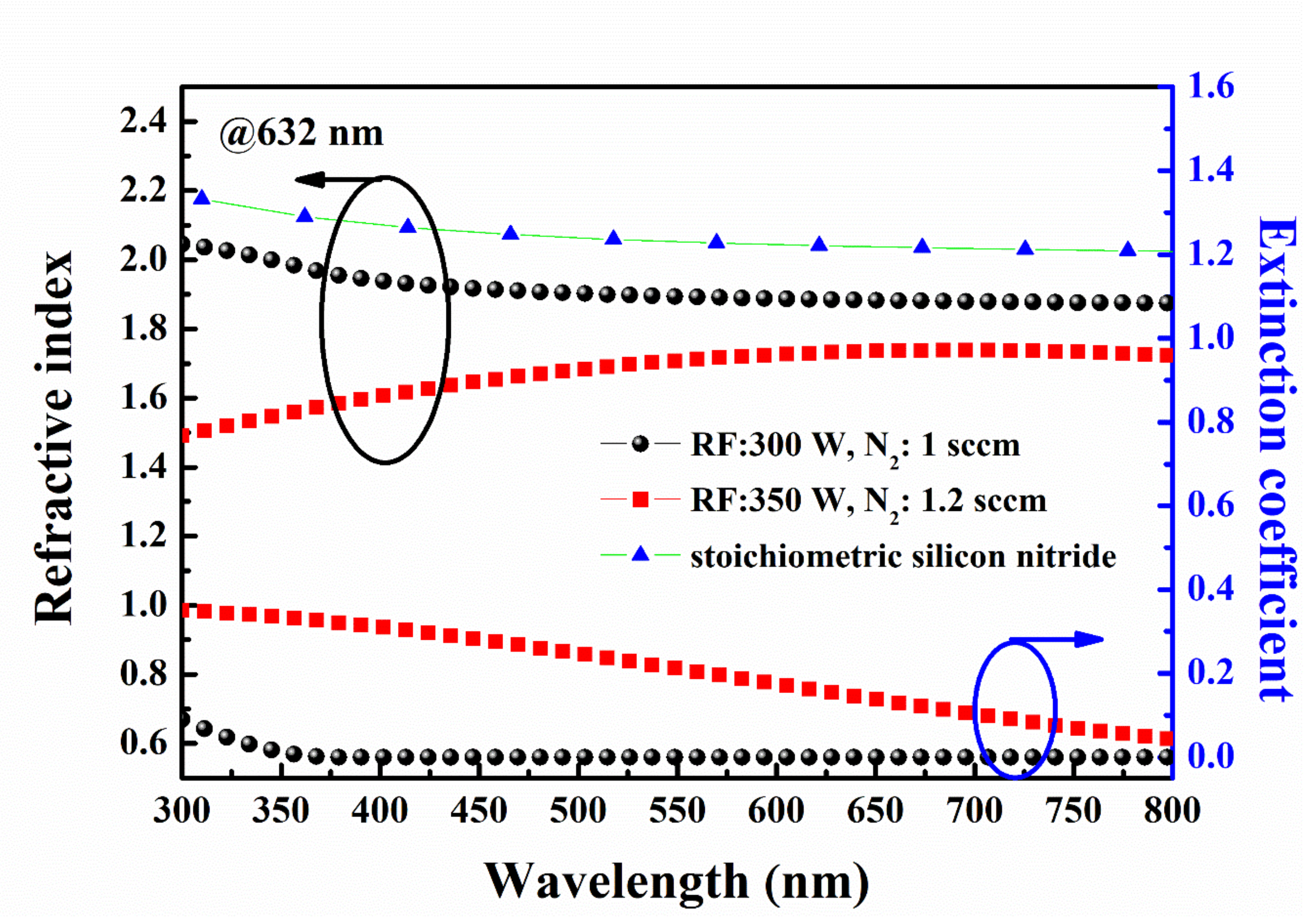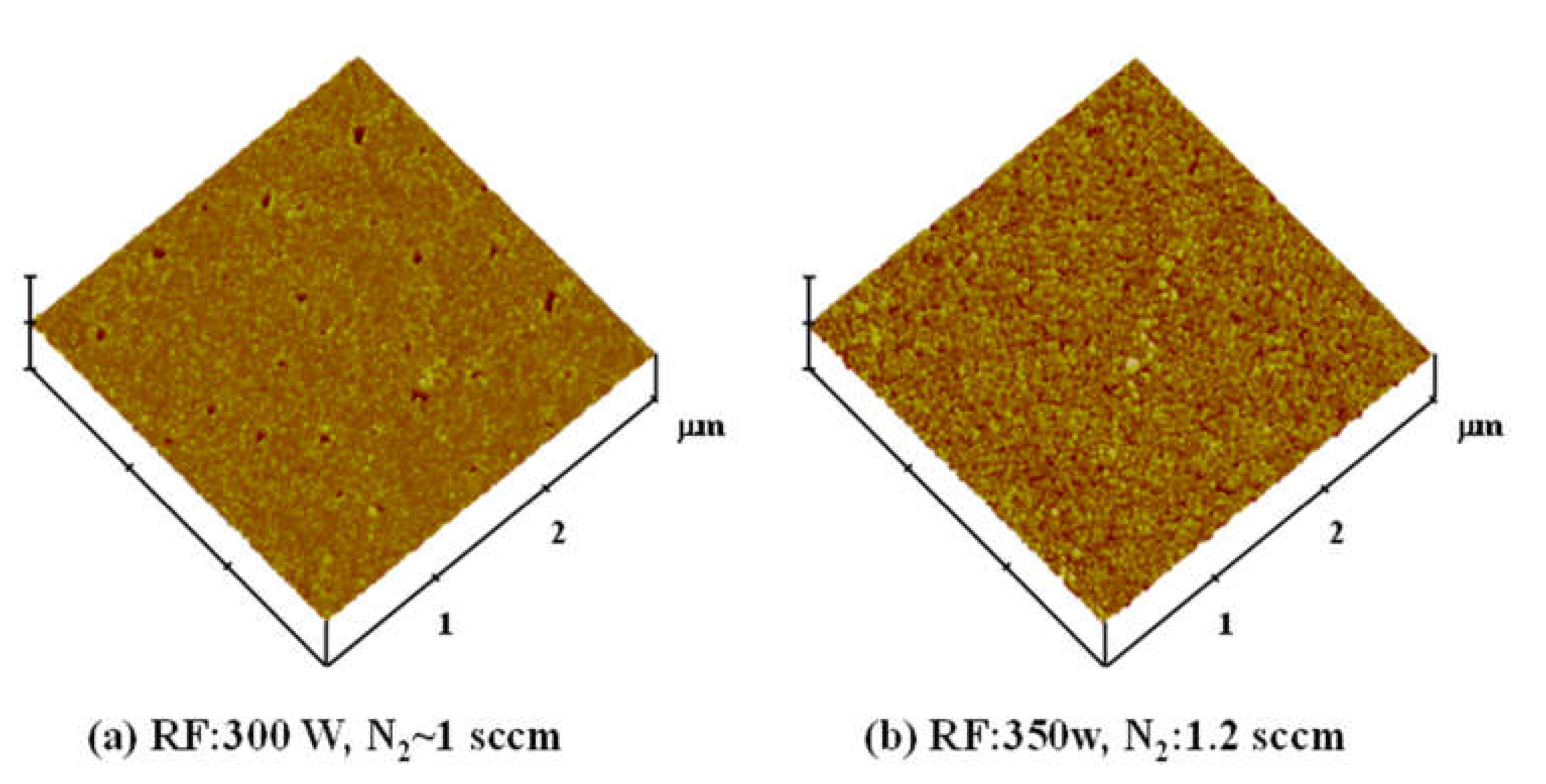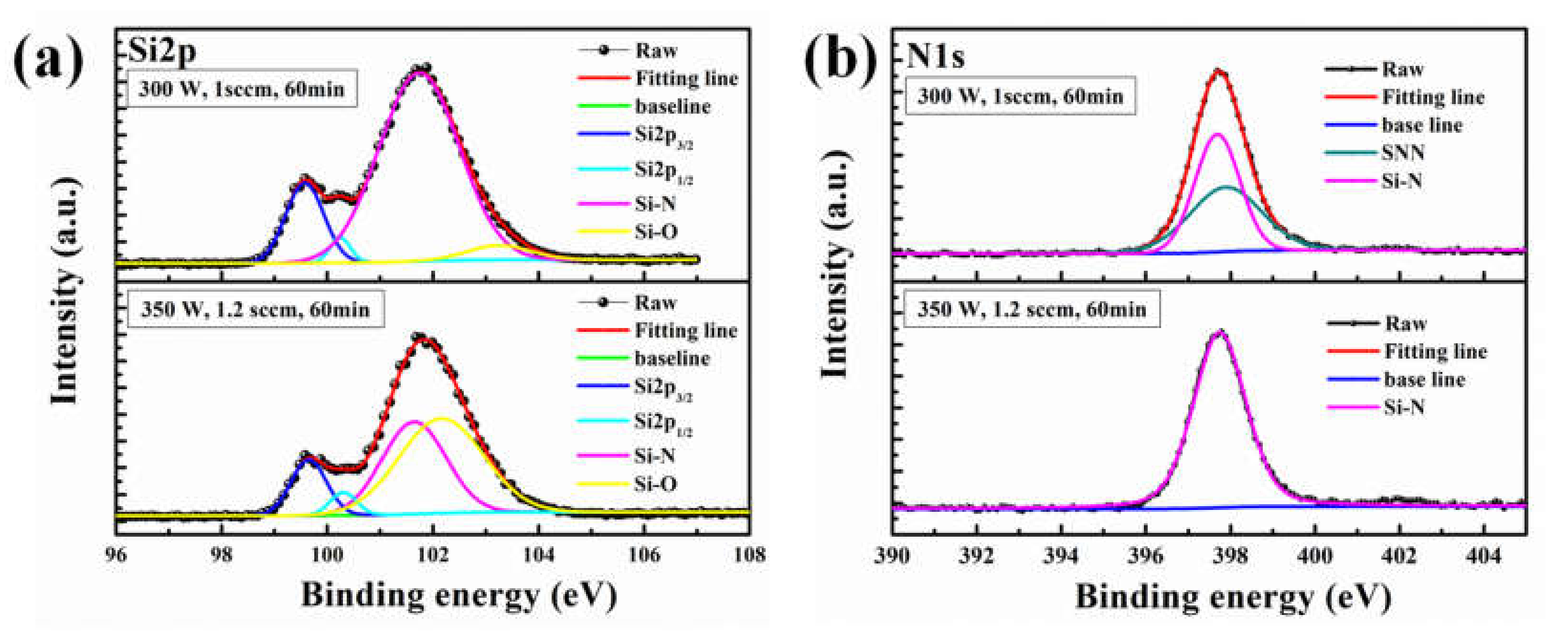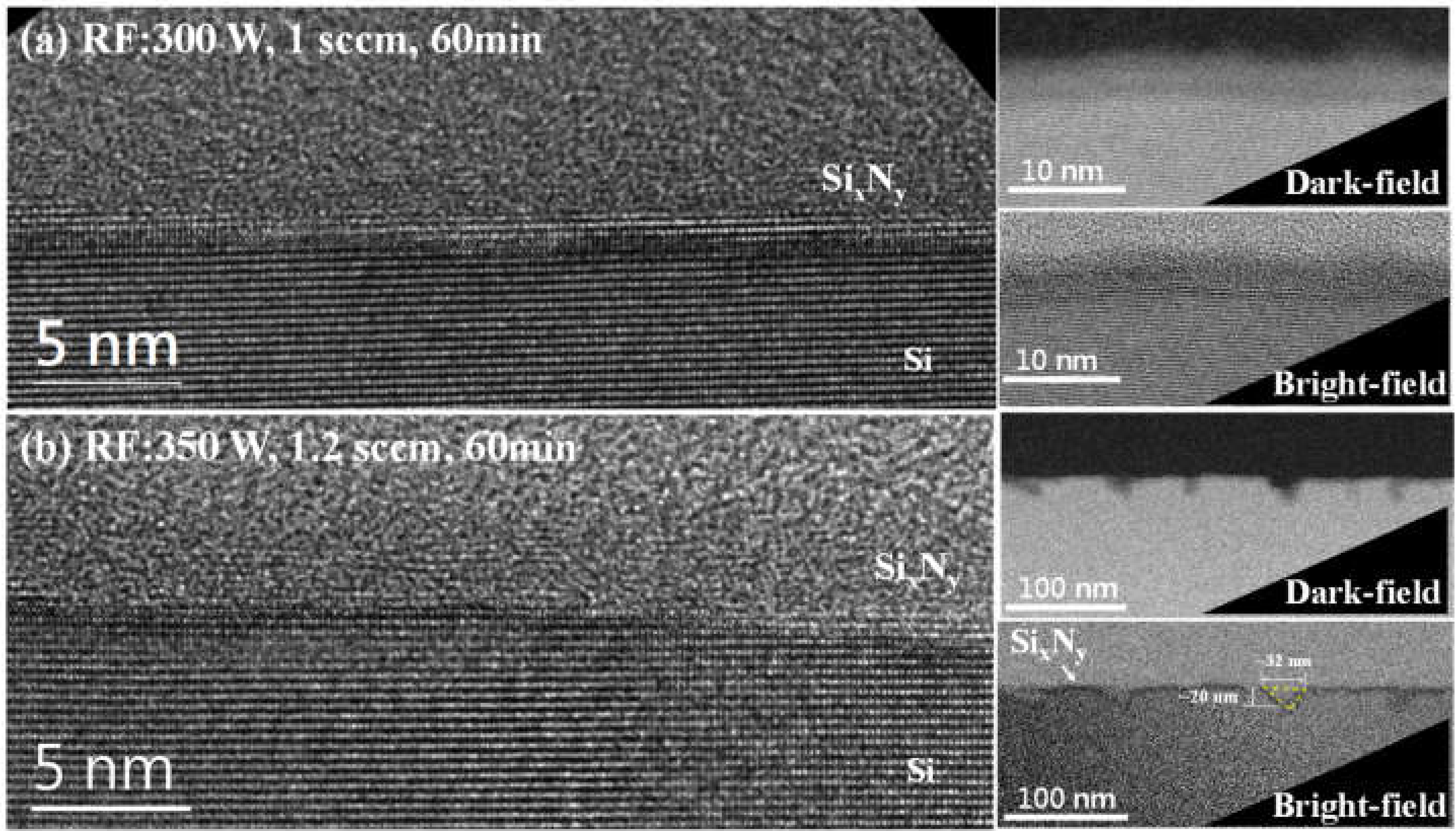Growth of Si3N4 Thin Films on Si(111) Surface by RF-N2 Plasma Nitriding
Abstract
1. Introduction
2. Materials and Methods
3. Results and Discussion
4. Conclusions
Author Contributions
Funding
Conflicts of Interest
References
- Ma, T.P. Making silicon nitride film a viable gate dielectric. IEEE Trans. Electron Devices 1998, 45, 680–690. [Google Scholar] [CrossRef]
- Riley, F.L. Silicon nitride and related materials. J. Am. Ceram. Soc. 2000, 83, 245–265. [Google Scholar] [CrossRef]
- Murakawa, S.; Ishizuka, S.; Nakanishi, T.; Suwa, T.; Teramoto, A.; Sugawa, S.; Hattori, T.; Ohmi, T. Depth profile of nitrogen atoms in silicon oxynitride films formed by low-electron-temperature microwave plasma nitridation. Jpn. J. Appl. Phys. 2010, 49, 49. [Google Scholar] [CrossRef]
- Higuchi, M.; Aratani, T.; Hamada, T.; Teramoto, A.; Hattori, T.; Sugawa, S.; Ohmi, T.; Shinagawa, S.; Nohira, H.; Ikenaga, E.; et al. Electric characteristics of Si3N4 films formed by directly radical nitridation on Si (110) and Si (100) surfaces. Solid State Devices Mater. 2006. [Google Scholar] [CrossRef]
- Unal, O.; Petrovic, J.J.; Mitchell, T.E. CVD Si3N4 on single crystal SiC: Part I, Characterization and orientation relationships at the interface. J. Mater. Res. 1992, 7, 136–147. [Google Scholar] [CrossRef]
- Kim, J.W.; Yeom, H.W. Surface and interface structures of epitaxial silicon nitride on Si. Phys. Rev. B 2003, 67, 035304. [Google Scholar] [CrossRef]
- Hwang, W.S.; Cho, B.J.; Chan, D.S.H. Effects of SiO2/Si3N4 hard masks on etching properties of metal gates. J. Vac. Sci. Technol. B 2006, 24, 2689–2694. [Google Scholar] [CrossRef]
- Kumar, M.; Rajpalke, M.K.; Roul, B.; Bhat, T.N.; Sinha, N.; Kalghatgi, A.T.; Krupanidhi, S.B. The impact of ultra thin silicon nitride buffer layer on GaN growth on Si (1 1 1) by RF-MBE. Appl. Surf. Sci. 2011, 257, 2107–2110. [Google Scholar] [CrossRef]
- Kumar, M.; Roul, B.; Bhat, T.N.; Rajpalke, M.K.; Misra, P.; Kukreja, L.M.; Sinha, N.; Kalghatgi, A.T.; Krupanidhi, S.B. Improved growth of GaN layers on ultra thin silicon nitride/Si (111) by RFMBE. Mater. Res. Bull. 2010, 45, 1581–1585. [Google Scholar] [CrossRef]
- Nakada, Y.; Aksenov, I.; Okumura, H. GaN heteroepitaxial growth on silicon nitride buffer layers formed on Si(111) surfaces by plasma-assisted molecular beam epitaxy. Appl. Phys. Lett. 1998, 73, 827–829. [Google Scholar] [CrossRef]
- Kijima, K.; Shirasaki, S. Nitrogen self-diffusion in silicon nitride. J. Chem. Phys. 1976, 65, 2668–2671. [Google Scholar] [CrossRef]
- Xu, Y.N.; Ching, W.Y. Electronic structure and optical properties of α and β phases of silicon nitride, silicon oxynitride, and with comparison to silicon dioxide. Phys. Rev. B 1995, 51, 17379. [Google Scholar] [CrossRef] [PubMed]
- Pandey, R.K.; Patil, L.S.; Bange, J.P.; Gautam, D.K. Growth and characterization of silicon nitride films for optoelectronics applications. Opt. Mater. 2004, 27, 139–146. [Google Scholar] [CrossRef]
- Yang, C.; Pham, J. Characteristic study of silicon nitride films deposited by LPCVD and PECVD. Silicon 2018, 10, 2561. [Google Scholar] [CrossRef]
- Yu, C.H.; Chiu, K.A.; Do, T.H.; Chang, L. Oriented Si3N4 crystallites formed by plasma nitriding of SiO2/Si (111) substrate. Surf. Coat. Technol. 2020, 395, 125877. [Google Scholar] [CrossRef]
- Signore, M.A.; Sytchkova, A.; Dimaio, D.; Cappello, A.; Rizzo, A. Deposition of silicon nitride thin films by RF magnetron sputtering: A material and growth process study. Opt. Mater. 2012, 34, 632–638. [Google Scholar] [CrossRef]
- Röttger, B.; Kliese, R.; Neddermeyer, H. Adsorption and reaction of NO on Si(111) studied by scanning tunneling microscopy. J. Vac. Sci. Technol. B 1996, 14, 1051. [Google Scholar] [CrossRef]
- Morita, Y.; Tokumoto, H. Origin of the 8/3 × 8/3 superstructure in STM images of the Si(111)-8×8:N surface. Surf. Sci. 1999, 443, L1037–L1042. [Google Scholar] [CrossRef]
- Schrott, A.G.; Fain, S.C., Jr. Nitridation of Si(111) by nitrogen atoms. Surf. Sci. 1982, 123, 204–222. [Google Scholar] [CrossRef]
- Ha, J.S.; Park, K.-H.; Yun, W.S.; Lee, E.-H.; Park, S.-J. Interaction of low-energy nitrogen ions with an Si(111)-7×7 surface: STM and LEED investigations. Appl. Phys. A 1998, 66, S495–S499. [Google Scholar] [CrossRef]
- Avouris, P.H.; Wolkow, R. Atom-resolved surface chemistry studied by scanning tunneling microscopy and spectroscopy. Phys. Rev. B 1989, 39, 5091–5100. [Google Scholar] [CrossRef]
- Tindall, C.; Li, L.; Takaoka, O.; Hasegawa, Y.; Sakurai, T. Scanning tunneling microscopy of N2H4 on silicon surfaces. Surf. Sci. 1997, 380, 481–488. [Google Scholar] [CrossRef]
- Yamabe, N.; Yamamoto, Y.; Ohachi, T. Epitaxial growth of β-Si3N4 by the nitridation of Si with adsorbed N atoms for interface reaction epitaxy of double buffer AlN(0001)/ β-Si3N4/Si(111). Phys. Status Solidi C 2011, 8, 1552–1555. [Google Scholar] [CrossRef]
- Hayafuji, Y.; Kajiwara, K. Nitridation of silicon and oxidized-silicon. J. Electrochem. Soc. 1982, 129, 2102–2108. [Google Scholar] [CrossRef]
- Ohachi, T.; Yamabe, N.; Shimomura, H.; Shimamura, T.; Ariyada, O.; Wada, M. Measurement of nitrogen atomic flux for RF-MBE growth of GaN and AlN on Si substrates. J. Cryst. Growth 2009, 311, 2987–2991. [Google Scholar] [CrossRef]
- Unal, O.; Mitchell, T.E. CVD Si3N4 on Single Crystal SiC: Part II. High resolution electron microscopy and atomic models of the interface. J. Mater. Res. 1992, 7, 1445–1454. [Google Scholar] [CrossRef]
- Malvost, H.; Michelt, H.; Ricardt, A. Correlations between active species density and iron nitride layer growth in Ar-N2-H2 microwave post-discharges. J. Phys. D Appl. Phys. 1994, 27, 1328–1332. [Google Scholar] [CrossRef]
- Tatarova, E.; Dias, F.M.; Gordiets, B.; Ferreira, C.M. Molecular dissociation in N2-H2 microwave discharges. Plasma Sources Sci. Technol. 2005, 14, 19–31. [Google Scholar] [CrossRef]
- Zhai, G.; Yang, J.; Cue, N.; Wang, X.-S. Surface structures of silicon nitride thin films on Si(111). Thin Solid Films 2000, 366, 121–128. [Google Scholar] [CrossRef]
- Ermolieff, A.; Bernard, P.; Marthon, S.; Camargo da Costa, J.J. Nitridation of Si(100) made by radio frequency plasma as studied by in situ angular resolved x-ray photoelectron spectroscopy. Appl. Phys. 1986, 60, 3162–3166. [Google Scholar] [CrossRef]
- Bolmont, D.; Bischoff, J.L.; Lutz, F.; Kubler, L. Use of an electron cyclotron resonance plasma source for Si(001) 2 × 1 surface nitridation by N2: An X-ray photoemission study. Surf. Sci. 1992, 269, 924–928. [Google Scholar] [CrossRef]
- Falta, J.; Schmidt, T.H.; Gangopadhyay, S.; Clausen, T.; Brunke, O.; Flege, J.I.; Heun, S.; Bernstorff, S.; Gregoratti, L.; Kiskinova, M. Ultra-thin high-quality silicon nitride films on Si. Europhys. Lett. 2011, 111, 94. [Google Scholar] [CrossRef]
- Zhang, B.; Liu, Y. A review of GaN-based optoelectronic devices on silicon substrate. Chin. Sci. Bull. 2014, 59, 1251–1275. [Google Scholar] [CrossRef]
- Dadgar, A.; Bläsing, J.; Diez, A.; Alam, A.; Heuken, M.; Krost, A. Metalorganic chemical vapor phase epitaxy of crack-free GaN on Si (111) exceeding 1 µm in thickness. Jpn. J. Appl. Phys. 2000, 39, L1183–L1185. [Google Scholar] [CrossRef]
- Luke, K.; Okawachi, Y.; Lamont, M.R.E.; Gaeta, A.L.; Lipson, M. Broadband mid-infrared frequency comb generation in a Si3N4 microresonator. Opt. Lett. 2015, 40, 4823–4826. [Google Scholar] [CrossRef]
- Palik, E. Handbook of Optical Constants of Solids; Academic Press: Orlando, FL, USA, 1985; p. 999. [Google Scholar]
- Wertheim, G.K.; Butler, M.A.; West, K.W.; Buchanan, D.N.E. Determination of the Gaussian and Lorentzian content of experimental line shapes. Rev. Sci. Instrum. 1974, 45, 1369–1371. [Google Scholar] [CrossRef]
- Caballero, D.; Martinez, E.; Bausells, J.; Errachid, A.; Samitier, J. Impedimetric immunosensor for human serum albumin detection on a direct aldehyde-functionalized silicon nitride surface. Anal. Chim. Acta 2012, 720, 43–48. [Google Scholar] [CrossRef]
- Li, N.; Hu, P.; Zhang, X.; Liu, Y.; Han, W. Effects of oxygen partial pressure and atomic oxygen on the microstructure of oxide scale of ZrB2–SiC composites at 1500 °C. Corros. Sci. 2013, 73, 44–53. [Google Scholar] [CrossRef]
- Kim, J.W.; Yeom, H.W.; Chung, Y.D.; Jeong, K.; Whang, C.N.; Lee, M.K.; Shin, H.J. Chemical configuration of nitrogen in ultrathin Si oxynitride on Si(100). Phys. Rev. B 2002, 66, 035312. [Google Scholar] [CrossRef]
- Li, H.-F.; Dimitrijev, S.; Sweatman, D.; Harrison, H.B.; Tanner, P.; Feil, B. Investigation of nitric oxide and Ar annealed SiO2/SiC interfaces by x-ray photoelectron spectroscopy. J. Appl. Phys. 1999, 86, 4316–4321. [Google Scholar] [CrossRef]
- Wu, C.; King, C.; Lee, M.; Chen, C. Growth Kinetics of Silicon Thermal Nitridation. J. Electrochem. Soc. 1982, 129, 1559–1563. [Google Scholar] [CrossRef]
- Wu, C.-L.; Chen, W.-S.; Su, Y. N2-plasma nitridation on Si(111): Its effect on crystalline silicon nitride growth. Surf. Sci. 2012, 606, L51–L54. [Google Scholar] [CrossRef]




| Sample Name | Sample A | Sample B |
|---|---|---|
| RF power | 300 W | 350 W |
| N2 flow rate | 1 sccm | 1.2 sccm |
| Nitridation time | 60 min | 60 min |
Publisher’s Note: MDPI stays neutral with regard to jurisdictional claims in published maps and institutional affiliations. |
© 2020 by the authors. Licensee MDPI, Basel, Switzerland. This article is an open access article distributed under the terms and conditions of the Creative Commons Attribution (CC BY) license (http://creativecommons.org/licenses/by/4.0/).
Share and Cite
Chen, W.-C.; Chen, S.; Yu, T.-Y.; Su, J.; Chen, H.-P.; Lin, Y.-W.; Cheng, C.-P. Growth of Si3N4 Thin Films on Si(111) Surface by RF-N2 Plasma Nitriding. Coatings 2021, 11, 2. https://doi.org/10.3390/coatings11010002
Chen W-C, Chen S, Yu T-Y, Su J, Chen H-P, Lin Y-W, Cheng C-P. Growth of Si3N4 Thin Films on Si(111) Surface by RF-N2 Plasma Nitriding. Coatings. 2021; 11(1):2. https://doi.org/10.3390/coatings11010002
Chicago/Turabian StyleChen, Wei-Chun, Sheng Chen, Tung-Yuan Yu, James Su, Hung-Pin Chen, Yu-Wei Lin, and Chin-Pao Cheng. 2021. "Growth of Si3N4 Thin Films on Si(111) Surface by RF-N2 Plasma Nitriding" Coatings 11, no. 1: 2. https://doi.org/10.3390/coatings11010002
APA StyleChen, W.-C., Chen, S., Yu, T.-Y., Su, J., Chen, H.-P., Lin, Y.-W., & Cheng, C.-P. (2021). Growth of Si3N4 Thin Films on Si(111) Surface by RF-N2 Plasma Nitriding. Coatings, 11(1), 2. https://doi.org/10.3390/coatings11010002







